When talking or thinking about light and what it really is, we can not help but wonder and be amazed by the subtle miraculous nature of life itself. The Universe is still more mysterious than we would like to admit and far more mysterious for us to completely comprehend, especially when it comes to quantum levels of it. Before we figuratively shrink ourselves down and travel to that quantum level, here is a list of previously published posts in my Physics explained series for you to check out:
VIBRATION
DOPPLER EFFECT
COLD BOILING WATER
THE NATURE OF WAVES
HOW DO WE SEE COLORS
LEARN ABOUT RAINBOWS
EVERYTHING IS MAGNETIC!
NEWTON'S LAWS OF MOTION
DIFFERENCE BETWEEN HEAT AND TEMPERATURE
CALCULATE THE SPEED OF LIGHT USING CHOCOLATE
Today, I will take you on a journey to discover the hidden knowledge that light holds and reveal to you the mystery of its dual nature for light is both a particle and a wave. Philosophically, if the Universe is showing us how the very essence of our existence can be two completely opposite things, why are we not learning from it and accepting that people can be more too? If light can be both, why are we so surprised at bisexual people or transgender ones? Why are we still not trusting those subtle truths that science is teaching us? Why are we not trusting the diverse nature of our Universe and still clinging to old ideas brought to us by small minds and big egos who promote tradition over progress? Maybe I am slightly digressing from the topic and maybe by the end of this post, you will see that I am really not. Read on and find out...
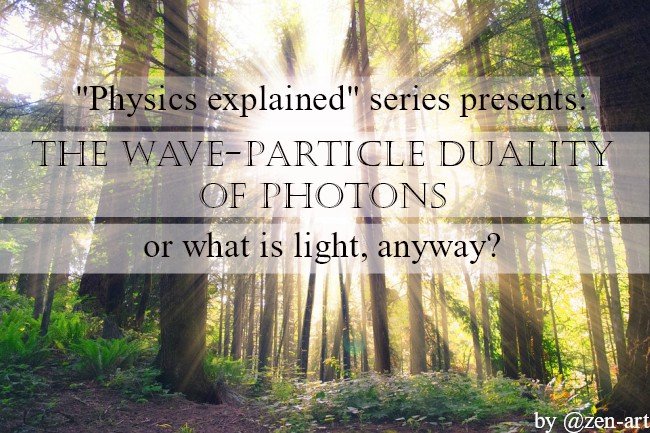
Royality free photo, Pixabay, author: Free-Photos, adapted by me
I often say that questions are more important than answers. I believe it is so because there would be no answers without questions. Rational thinking and questioning the world around us is important, that is the true essence of science, to question. With every answer, two new questions are born. Progress, the evolution of thought and idea accompanied by our thirst for knowledge is what keeps pushing us forward. As with any other scientific topic, this one too will not answer the questions starting with WHY but those starting with HOW. We can not understand the why's before me know the how's. Let's see what we can learn about light, are you ready?


When you see a beam of light coming through the leaves in the forest or shining your room in the morning, that beam is filled with zillions of packets of light that we call photons. Photon is a quantum of electromagnetic radiation, the smallest amount of that radiation and the basic unit of light.
When we say that the speed of light is 3 x 10^8 m/s (denoted with lower letter c), we are saying how that is the speed of photons in vacuum. These little particles are always moving and with a constant speed of c. When we want to symbolize a photon, we can either use hν (h for Planck constant and the Greek letter nu for the photon's frequency) or hf (h for Planck constant and f for the photon's frequency) but the Greek letter gamma γ is also often used. hf represents energy of the photon and is from Einstein's light quantum theory which we will get to later. For now, let's see some basic photon properties:
- they are stable
- they have no electric charge
- they have zero mass and rest energy
- they only exist as moving particles
- they are particles with the spin-1 (bosons)
- they can be destroyed or created by natural processes
- they travel at the speed of c in a vacuum


The nature of light was (still is) one of the greatest scientific debates and philosophers and scientists alike debated it throughout the history. Long long time ago, somewhere around the sixth century BC, there was a Hindu philosophy called Vaisheshika that believed how light was made of very fast-moving parts called tejas which were different from those of earth, air, fire, and water parts that our world is based on. It is interesting to see how, even back then, there was a physical intuition present about light particles being different from all the other ones.
The ancient Greek physicist Euclid proclaimed how light travels in straight lines around 300 BC (he is the one in the image to the right) and it was Ibn al-Haytham in 1021 who explained the laws of refraction in his work "Book of Optics". There was also René Descartes’ with his essay La dioptrique in 1637 in which he said that light is made of pulses that propagate instantaneously when contacting ‘balls’ in a medium and Christiaan Huygens came in 1690 with his Traité de la lumière that showed light as compressible waves in an elastic medium that can be reflected and refracted. This is when the scientific community broke in two. There were those who believed the light was a wave on one side and those that promoted light being particles on another.
The theory of how light is a collection of particles was more popular and it stuck for a very long time, the entire 18 century to be more exact. Newton was the loudest of the promoters. Then came May of 1801, the beginning of a new era of light when Thomas Young presented his two-slit experiment that showed the interference of light and interference means waves.
Young (seen in the image to the right) also used the data from his experiment to calculate the wavelengths of various colors of light. His experiment provided a solid evidence that light was a wave and not a particle. Those in favor of light being a particle did not get discouraged by this since they too had some work done that was in favor of their theory, particularly the work regarding polarization but that too did not last long. In 1821, Augustin Fresnel showed how polarization could be explained by light being a transverse wave with no longitudinal vibration. So... Light is a wave and they agreed on that, right? Wrong. There was still a mystery on how it travels since a medium was required for a wave to propagate. Maxwell to the rescue...
"The agreement of the results seems to show that light and magnetism are affections of the same substance, and light is an electromagnetic disturbance propagated through the field according to electromagnetic laws"
Maxwell in 1865
In 1861, James Clerk Maxwell explained both experimental and theoretical knowledge about electricity and magnetism in 20 equations and proclaimed how an electromagnetic wave can self-sustain even in a vacuum which means the aether is not required for light to propagate. His work served as a starting point for many other scientists to work on. Max Planck came in 1900 with his packets of energy — quanta and Einstein showed in 1905 how light is quantisized too. He even received the Nobel Prize in Physics for his explanation of the photoelectric effect that "proved" light is a particle. Einstein's theory was that light is a photon and the movement of those photons is a wave. He was the first one to introduce how light is both, a particle and a wave and one of his main points was that light's energy is related to its oscillation frequency.
It wasn't until 2015 when we got the first photo of that dual behavior of light. Swiss physicists at the École Polytechnique Fédérale de Lausanne led by Fabrizio Carbone performed an experiment in which they used a laser to fire onto a nanowire and cause electrons to vibrate. You can see the images and read about the experiment here:


Since I did mention the double slit experiment and you can not really have an explanation of light without it, let's see what it is about.
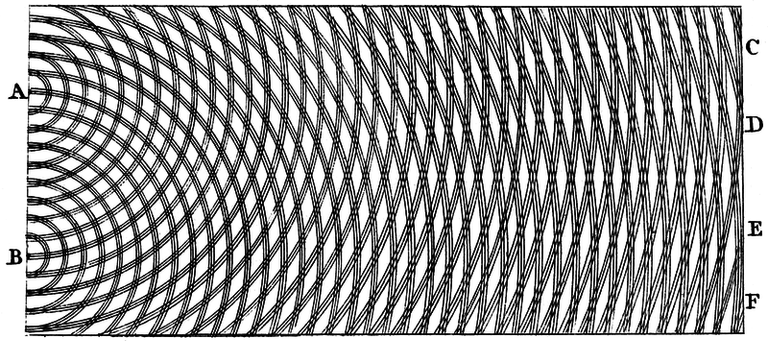
Young Diffraction from wiki, public domain
When the Sun's rays encounter the screen with a single narrow slit, they spread out to produce a single wavefront. This is how waves usually behave. When that wavefront reaches the screen that has two narrow slits (A and B in the image above), both those slits are considered to be the two new sources of light when the light passes them, two additional sources of coherent light. Now we have two wavefronts and as any other wavefronts, those two can interfere with each other by causing constructive or destructive interference. When waves that meet out of step come together, they will cancel each other out and create a destructive interference and when they are in step (in phase) they will create a constructive interference. That is why the final image is made of light and dark fringes. Light fringes are constructive interference places and dark fringes are the destructive ones. We can shoot electrons instead of photons because they too show this kind of behaviour. In 1961, Claus Jönsson of the University of Tübingen performed the experiment with electron beams and In 1974, the Italian physicists Pier Giorgio Merli, Gian Franco Missiroli, and Giulio Pozzi repeated the experiment using single electrons and biprism. They showed that each electron interferes with itself. Yes, electrons behave like waves too. Mind blown yet? If not, you will be soon...
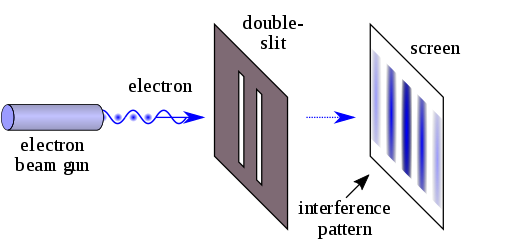
Double-slit from wiki, Creative Commons CC0 1.0
To understand why this proved that light was a wave, consider the following thought experiment. Imagine a hole in the wall through which you are throwing little balls and let's say those balls have the ability to stick to any surface like they are made of silly putty. When you start throwing balls through the hole, what kind of pattern do you expect to see on the wall behind the hole? It should be the pattern in the size of the hole, right? It should and it will in this case because you are throwing balls and if the light was made of particles it would show the same pattern because particles would behave like, well... Particles. With light, we got the interference pattern and that proves how light is a wave. I did say that a mind-blowing moment will come and here it is... This experiment also proves that light is a particle. How, you wonder?
Here is what happens,
step by step...
1. Silly putty balls
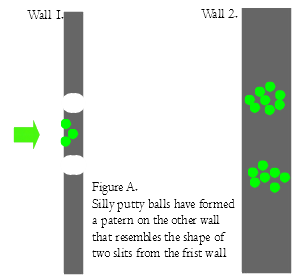 (Figure A, made and owned by me, original, royality free)
(Figure A, made and owned by me, original, royality free)Imagine a wall with two slits in it and a wall behind it. You are throwing silly putty balls through it. Since you are not a perfect shooter, some balls will miss the slits and hit the first wall all around the slits but some you will manage to send through the slits. Some will pass through one slit and some will pass through another. Those that do pass through will stick to the second wall creating a pattern that resembles that of two slits from the first wall.
2. Quantum level
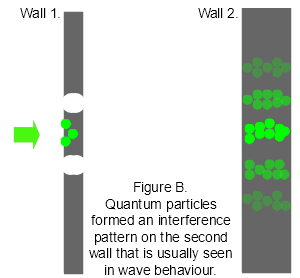 (Figure B, made and owned by me, original, royality free)
(Figure B, made and owned by me, original, royality free)Now imagine that instead of silly putty balls you have a cannon that is shooting tiny quantum particles. They can be photons or electrons, you choose. Since shooting tiny quantum particles is like shooting small balls, we would expect to see the same pattern, right? Nope. When quantum particles go through those two slits, they will replicate the stripy interference pattern from a wave. They will form a wave if you fire them one by one or if you fire them all at once, that does not matter. How can a bunch of particles do this? One of the explanations is that electron splits, passes through both slits, interacts with itself on the other side and then recombines and hits the wall as a single particle again. How can we see through which slit an electron passes and what happens on the other side? We could place a camera or a detector of some kind to see what is going on. Let's do that...
3. Quantum level with the observer
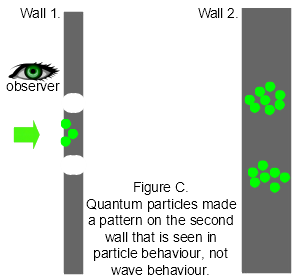 (Figure C, made and owned by me, original, royality free)
(Figure C, made and owned by me, original, royality free)Let's put the observer by the two slits to see what is going on. There is a number of tiny cameras with enough magnification that we can use. Ups! What just happened? Did we just get the pattern like that from silly putty balls? Yes we did. When we placed a detector by the slits, electrons started behaving differently. Did they know they were being watched? How crazy is that? Not that crazy actually. It proves that the act of observing a quantum system has a profound effect on that system and it is still not clear why it happens. Quantum particles behave differently here and their behavior depends on if they are being watched or not.
CONCLUSION about quantum particles?
When we do not look, they act like a wave.
When looked at, they act like particles.
I TOLD YOU IT WAS MIND-BLOWING...


The photoelectric effect suggested a particle nature for light. As I mentioned earlier, Einstein received a Nobel prize for it. In 1905, Einstein postulated the existence of photons with particulate qualities that carried the minimum amount of light energy.
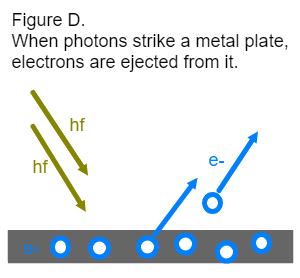 (Figure D, made and owned by me, original, royality free)
(Figure D, made and owned by me, original, royality free)Einstein observed how when the light hits certain metals, it would lead to an electric current in a circuit. He thought that light was knocking electrons out of the metal somehow and also found out that not all light did that. Blue did but on the other hand, the red light did not. Einstein explained this with his postulation how electrons can receive energy from the electromagnetic field only in discrete portions and he called those portions quanta. An amount of energy E of that quanta is related to the frequency f of the light and the Planck's constant (6.626 × 10^−34 J seconds).
E = h*f
Not all photons can eject an electron from the metal, only those with a high enough energy can and that is why blue light could eject an electron and the red one could not.
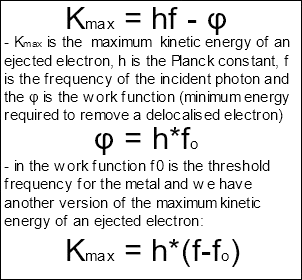
(image made and owned by me, original, royality free)
What happens exactly? An electron within some material absorbs the energy of one photon. If the energy of an electron is then larger than its binding energy (work function), that electron will be ejected and if the energy of a photon is too small, the electron will not increase its energy high enough to be able to escape the material. The interesting thing is that electron always absorbs all the energy of the photon, never just a part of it and a photon stops existing. With that absorption, some of the photon energy is absorbed and some contributes to the electron's kinetic energy. Einstein's theory was solidified in the 1920s by the experiments of American physicist Arthur H. Compton who demonstrated that photons had momentum and then came Louis-Victor de Broglie who proposed that all matter and radiation have properties that resemble both a particle and a wave. Oh yes, all. That is why I told you that you can imagine throwing both photons or electrons through those slits in our experiment earlier.


In 1924, de Broglie formulated the de Broglie hypothesis which states how all matter has a wave-like nature and he connected wavelength ( λ) with and momentum (p).
λ = h/p
De Broglie was awarded the Nobel Prize for Physics five years later for his hypothesis but two years before he received the prize, there were two independent experiments that confirmed his work. At the University of Aberdeen, George Paget Thomson passed a beam of electrons through a thin metal film and observed the predicted interference patterns, and at Bell Labs, Clinton Joseph Davisson and Lester Halbert Germer guided their beam through a crystalline grid. Thomson and Davisson shared the Nobel Prize for Physics in 1937.


Let's say that after covering everything so far, we agree that light exhibits behavior of both particles and waves but how does it travel? How can the light from the Sun reach Earth and our eyes? Are there zillions of photons traveling like particles in some sort of beams or is the light traveling like a wave? We do know that a wave needs medium to travel and we have learned that light is a wave but how does that come to terms with vacuum in space? This is where we have to accept that not all waves need a medium, light as an electromagnetic wave does not need it. Yeah, I know. In my last post, I explained how something must vibrate in order for a wave to appear. Something is vibrating here indeed. Electric and magnetic fields are vibrating.
The first thing you have to realize is that space in the Universe is not empty. It is filled with electromagnetic radiation, dark matter, dark energy and so on. There is no such thing as the real physical vacuum. A vacuum is only a concept that we can come close to in our labs but never produce it with absolutely no particles whatsoever. However, since the space between planets has so fewer particles than we have on Earth, we often call it vacuum because of that comparison with the number of particles here. Just imagine trillions of sand particles in one room and only one in another, you could say there is no sand in the other room but you would be wrong. I am digressing, let me come back to the point...
The question of how light travels through space is one of the mysteries of physics. To ask me to explain it is to ask me to present a Nobel worthy post. Sorry to disappoint you my dear readers but I am not capable of that, at least not yet lol, who knows, maybe someday. What I can offer you are the modern explanations that far more smarter people than me have proposed. Light is an electromagnetic wave, a wave of electric and magnetic energy oscillating very quickly and yes, it also travels in a stream of tiny particles called photons. How does the light travel then? it travels like both a wave and a particle.


The time has come to slowly end this post and to not leave you more confused then you were when we started, let's review what we have covered and explained (or at least tried to explain).
Light is a complex-valued probability distribution that has quantized (discrete) properties. Depending on the situation, it sometimes acts like a wave and sometimes acts like a particle.
The smallest piece of light is called a photon and just like a wave, a photon bends around corners (diffraction), makes fringed patterns (interference), bends when entering a material (refraction), has a wave-shape spreading (dispersion), can be reflected, and has a frequency. Photon behaves like a particle too and just like a particle it has a fixed energy, a fixed momentum, a fixed spin and can have a single fixed location in space. According to the Heisenberg Uncertainty Principle, wave and particle traits of photons interchange and the more we force a photon to act like a particle, the less it will behave like a wave. The wave-particle duality is not restricted only to photons. All quantum particles behave as quantized probability distributions.
If you are interested in learning more (and I hope you are), check out these references:
The wave-particle duality of photons from photonterrace.net
What exactly is a photon? from zmescience.com
Double-slit experiment from wikipedia.org
Physics in a minute: The double slit experiment from plus.maths.org
Photoelectric effect from wikipedia.org
Light: Particle or a Wave? from olympus-lifescience.com
Wave–particle duality from wikipedia.org
How Does Light Travel? from sciencing.com
Is light a particle or a wave? from wtamu.edu
Wave-Particle Duality from hyperphysics.phy
KEEP YOUR SMILE ON,
RESPECT YOUR INNER GENIOUS!

If you are interested in something physics (or science in general) related, tell me and I would be happy to make a post about it and explain it. Promoting science and making it understandable gives me great joy, I would be happy to help you.

Image sources AND LICENCES in order of appearance:
- cover image is from pixabay and is free for personal and commercial use, you can find it here
- line divider that I use is from FREE CLIPART LIBRARY, and is here
- images of titles are made by me using the Sun image from pixabay that can be found here
- light beam in the forest is from pixabay and is here
- Eucklid is from wikipedia, can be found here and is in the public domain with license description available on that link
- Young is from wikipedia, can be found here and is in the public domain with license description available on that link
- difraction pattern is from wiki, can be found here and is in the public domain with the license info on the link
- blue double slit image is from wiki and is from here. It is under Creative Commons CC0 1.0 Universal Public Domain Dedication that is provided on the link
- figures A, B, C, and D I made by myself using a simple editor, you can use them in any way and anywhere you like without giving me any credit
- image with formulas and explanations for max. kinetic is made by me and yes, you can use it whenever and wherever you want without giving me any credit
- sunrise image is from pixabay and can be found here
- my bitmoji avatar was created on https://www.bitmoji.com/, visit the site to create yourown
All images used in this post are free for commercial use, if you have a reason to believe otherwise please contact me with the proof and I will make the proper corections. Thank you.
PROUD MEMBER OF:



@steemitbloggers






























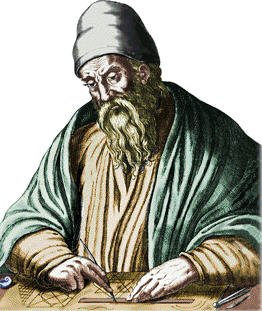

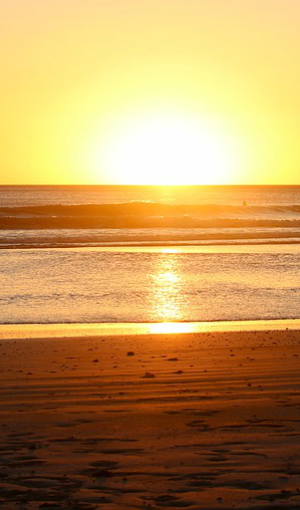
This post has been voted on by the steemstem curation team and voting trail.
There is more to SteemSTEM than just writing posts, check here for some more tips on being a community member. You can also join our discord here to get to know the rest of the community!
Thank you, you made my day with this, much love to everyone involved in your community 💚💚💚
Congratulations! This post has been upvoted from the communal account, @minnowsupport, by zen-art 💚 from the Minnow Support Project. It's a witness project run by aggroed, ausbitbank, teamsteem, someguy123, neoxian, followbtcnews, and netuoso. The goal is to help Steemit grow by supporting Minnows. Please find us at the Peace, Abundance, and Liberty Network (PALnet) Discord Channel. It's a completely public and open space to all members of the Steemit community who voluntarily choose to be there.
If you would like to delegate to the Minnow Support Project you can do so by clicking on the following links: 50SP, 100SP, 250SP, 500SP, 1000SP, 5000SP.
Be sure to leave at least 50SP undelegated on your account.
This I knew very little about and it was such an interesting read
I am glad you enjoyed the read, thank you 💚
@zen-art Most welcome
Congratulations! Your post has been selected as a daily Steemit truffle! It is listed on rank 21 of all contributions awarded today. You can find the TOP DAILY TRUFFLE PICKS HERE.
I upvoted your contribution because to my mind your post is at least 15 SBD worth and should receive 193 votes. It's now up to the lovely Steemit community to make this come true.
I am
TrufflePig, an Artificial Intelligence Bot that helps minnows and content curators using Machine Learning. If you are curious how I select content, you can find an explanation here!Have a nice day and sincerely yours,

TrufflePigWith Young's experiment it was quite obvious that light behaved as a wave.
With huygens explaination of light propagating as wave already explained phenomena like refraction and diffraction .
Newton's idea of light being corpuscular however failed to explain anything beyond linear propagating light Rays.
But since newton had a huge reputation as a scientist,most of the scientific community decided to stick with his idea for a long time
Newtons idea also describes what you measure when you throw individual photons at a detector. They deposit their energy in one single well defined point.
What I mean to say is Newton's idea of corpuscular light had very less application to the whole of light phenomena.
However because of his reputation as a great scientist, the majority scientific community sticked to his idea for like a century.
The wave nature idea however at the very same time in history explained lot more than the corpuscular theory
Posted using Partiko Android
nice post to read! I think you could have stated more directly that light is neither a particle nor a wave. This point often confuses people, how could it be both? It simply is neither, just in some cases it could be approximated by a wave and in some by a particle. But there is never a conflict and there are cases where it behaves entirely different. It is only our limited classical mind that tries to put it into known categories.
Your picture of tiny cameras filming is misleading. The reason why an observation on the quantum level changes the result is that there is no measurement without interaction. And when there is an interaction a minimum amount of energy has to be transmitted. But because we are talking about quantum systems that will be an order 1 correction.
The picture of a tiny camera, a passive observer, therefore is not correct.
Another way to see it is that a gain of information is necessary connected to a collapse of the wave-function. The measurement interacts with the system to enforce that collapse.
Nicely said. As for the camera, every measurement impacts the thing that is measured because everything interacts with everything especially on the quantum level but I do not see it as misleading because I think my readers are smarter than thinking there is a giant eye watching the experiment like shown in the picture. It is there to better help the reader to understand the difference between what happens with no recording and with the recording. For everything else, there are reference links that a person can check to learn more. Thank you for your insightful comment.
i hope you do not overestimate your readers :) I once talked to somebody claiming that when doing the double slit and making a measurement at the slits and storing it on a computer, the pattern changes when the hard drive is erased, because now that information is no longer there.
The reason I mention this is because to many people the measurement affecting the experiment seems to be something almost mystical. But its not, it is just that we are approaching the minimum possible energy states and then there are no smaller energy states that could be used to measure them. Therefore it is obvious that the process of measurement changes the system and changes the outcomes. Of course this has numerous interesting philosophical consequences.
This is the funniest thing I have read this morning LOL :D :D :D
As for my readers, my optimism sometimes kills the realism but maybe it should because I am pretty satisfied with how my scientific texts are received regarding the comments and views people leave after reading them. People are open and even if they do not understand, they ask for more clarification and that is really nice, it shows interest.
Oh, good grief.
This is actually a thing. This is why physics and I will never get along.
Whenever I want a smile, I just read this comment, thank you honey. Your love is appreciated and these lovely honest comments of yours are adorable and so so funny 💚
Congratulations! This post has been chosen as one of the daily Whistle Stops for The STEEM Engine!
You can see your post's place along the track here: The Daily Whistle Stops, Issue 226 (8/14/18)
The STEEM Engine is an initiative dedicated to promoting meaningful engagement across Steemit. Find out more about us and join us today.
Thank you 💚💚💚
This is really captivating. Not a lot of posts like this one, I'm lucky I found it. Buddha said that nothing is real that can be perceived by our senses, and explained most of what we know about physics back then. The thing that gets me is: if you take all of the solid of what makes up this planet and condensed it so that there was no space between, then you would have a very dense football size world left. So perhaps we just imagine all that there is and that light is only the energy given off by our exertions...
That is a very interesting take on this, thank you for sharing it. We still have so much to learn and so much to discover, who knows what is still out there to be found 💚
I think that the 2 slit experiment is the best at showcasing this duality. I wrote an essay on it a few semesters ago and it was one of the most interesting things I've written about. Richard Feynman has some really good presenations on it.